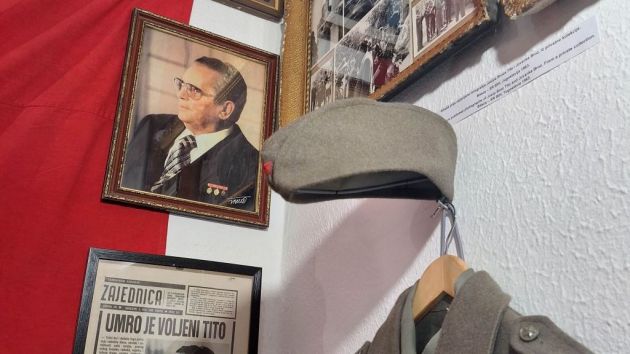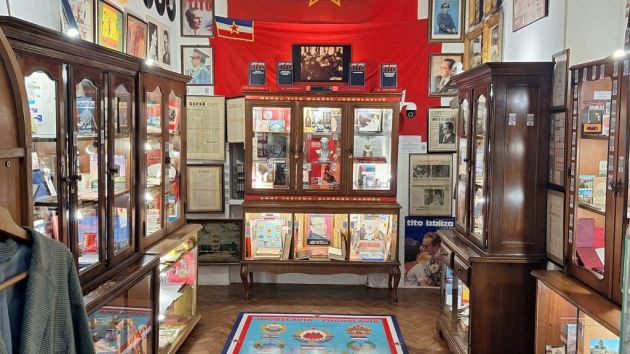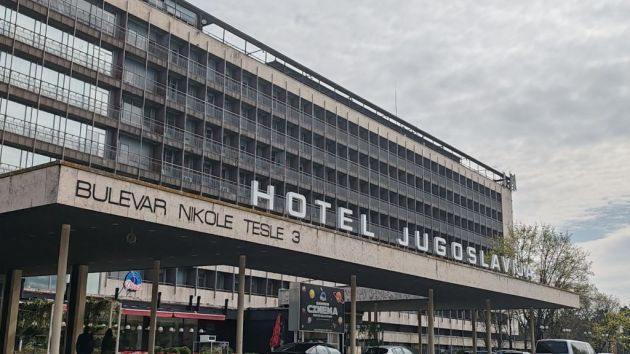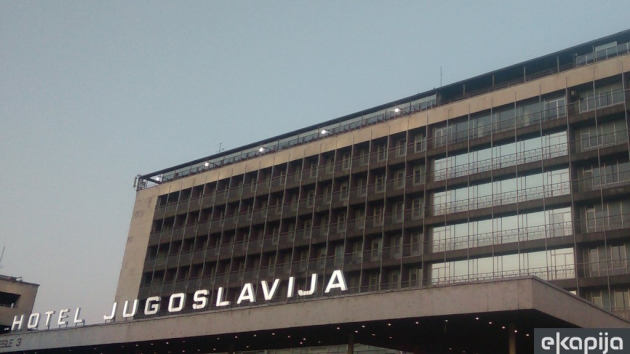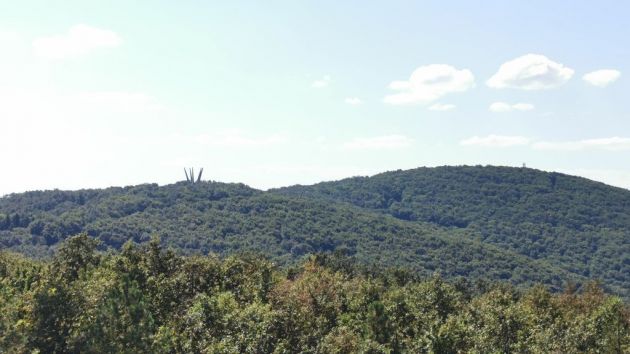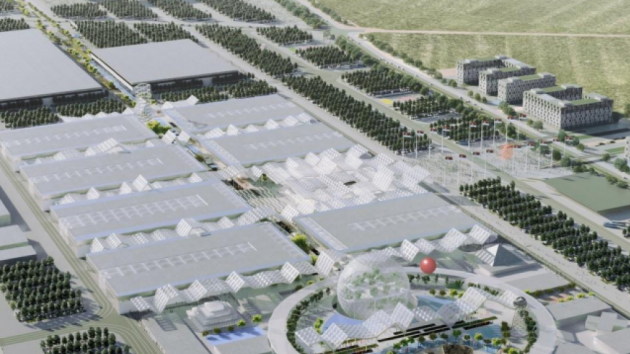Do You Know Where the First Tito-Themed Museum Created After the Breakup of Yugoslavia Is Located? – Two Small Rooms Without Workers, No Cash, QR Codes Instead of Explanations
Source: eKapija
 Monday, 01.04.2024.
Monday, 01.04.2024.
 10:21
10:21
 Monday, 01.04.2024.
Monday, 01.04.2024.
 10:21
10:21
(Photo: Milutin Labudović)

This is not the kind of museum you are used to. There are no workers, no free days, and they don’t take cash either.
The two small rooms in an apartment on the ground floor of a building in Ferhadija Street in central Sarajevo can be visited every day between 9am and 10pm. The ticket, which costs 10 convertible marks (5 euros) is bought at a machine and paid exclusively by card.
Don’t be fooled by the modern entrance – as soon as you go through the door featuring a five-pointed star, you are welcomed by the lyrics to the song “Zemljo moja” by Ismeta Krvavac and you will step into a time-machine.
Despite the name, it’s not just a Tito-themed museum, but also a museum about life in Yugoslavia, so everybody who lived in those times will nostalgically recognize objects from their childhood, their army service days, or their adulthood.
The ticket is paid exclusively by card (Photo: Marija Dedić)

Comrade Seid drove a passenger car without a right-hand light
In only two small rooms, there was an impressive number of exhibits depicting all the aspects of the citizens of the former Yugoslavia, from the school, through the army, to the housing. Yugo’s steering wheel, skis, Yassa jackets and ski-suits, women’s sandals, money, popular movie posters, needlepoints and samples of wallpapers that used to decorate homes in Yugoslavia tell stories about life in these areas.
Instead of classic explanations that would take up precious space, foreigners and those who were not yet born at the time will be able to scan the QR codes next to each item and thereby learn about the history of a country that is no more.
QR codes instead of classic museum explanations (Photo: Milutin Labudović)

Pioneers from the former Yugoslav era will smile when they see the book covers of Adventures of Nikoletina Bursac, Eagles Fly Early, Sutjeska, but also How to Learn. Women will recall titles like Mother and Child, A Perfect Housewife, A Book for Every Woman.
How popular advice books were is also shown by the guidebooks How to Maintain a Modern Apartment, Sanitary Installations – Maintenance and Repair, the unsurpassed Etiquette and Rules of Conduct in Nature, as well as a book whose title remains current even today: Europe for Us, subtitled “How to Arrive, Sleep, Eat, Visit, Shop, and Not Spend a Fortune”.
Fans of travel will enjoy postcards from popular Yugoslav summer vacation sites, old train and bus tickets, and a suitcase has also found its place in this small museum.
Thanks to the cigarette boxes, smokers will be enveloped in the aromas of the Lord, Drina, Zeta, Jadran and Kent brands. Younger visitors will be surprised by the look of the old radio devices and TVs, with instruction guides published in newspapers advising the readers to put the TV set at a distance of three meters and then watch the program with discreet room lighting.
In the part which represents a kitchen, you will see plates, coffee and sugar pots which are still present in many homes and an ad for Kinder Lada.
The bathroom features a washing machine, the first such device in Yugoslavia, of course, produced by Gorenje, a heater, a scale, a hairdryer, hair curlers and the Kalodont toothpaste brand, which later became synonymous with all toothpastes.
Yassa jackets, military uniforms and children’s works (Photo: Milutin Labudović)

The museum also displays valuable items such as the never-published photograph from the opening of the Sarajevo Cable Car in 1959, as well as the never-published photographs from the collection of Mirza Delibasic.
There’s also the Zdravko Colic single “Druze Tito mi ti se kunemo” (1980), which was issued about ten days before Tito’s death and sold an incredible 300,000 copies. Albums by Lepa Brena, Crvena Jabuka, Kemal Monteno and a VHS of Audicija show what the people of Yugoslavia liked to watch and listen to.
And what their army service day were like can be seen from the exhibited uniform, letters, postcards and photographs from the army, food recipes from the Yugoslav People’s Army and permits to leave the barracks.
The order, work and discipline are shown by the penalty issued to comrade Durgut Seid, who is ordered to pay a thousand dinars by decision of the Municipal Misdemeanor Court in Sarajevo for driving a passenger car with a malfunctioning right-hand light on the date of October 29, 1985, (long after Tito’s death) at around 7pm at 1 Visnjik Street.
Do you still have some of these in your kitchen? (Photo: Milutin Labudović)

Award of 100,000 Reichsmarks in gold
The name of the museum is justified by a whole range of items dedicated to the life-long president of the Socialist Federal Republic of Yugoslavia – framed photographs, a bust, badges bearing his image, but also books: Tito’s New Year’s Messages, Tito’s War Career, Josip Broz Heading a Military Column, It Was Honorable Living with Tito.
You will see parts of school papers where pupils and students wrote “Tito worked, Tito went to war, He was wounded there, Tito brought us peace and joy, Lucky is our people to have had Tito.”
An ad signed by the commander of the German troops in Croatia reminds of the beginning of the Second World War. Under the slogan of Life, Peace and Protection, it notifies that “anyone who delivers the communist leader called Tito to the German territories, alive or dead, will get an award of 100,000 Reichsmarks in gold.”
– The villain Tito is a bane of Your country. As a Bolshevik agent, he wants to turn Your country, with Moscow’s support, into a Soviet republic – the ad says and notes that “the removal of that villain is a national duty.”
The corner dedicated to Tito (Photo: Milutin Labudović)

Also inevitable are newspaper articles which inform that “on the day of May 4, 1980, at 3.05pm, in Ljubljana, the big heart of the president of our SFRY stopped beating” and notes that “heavy pain and deep sorrow infuse the working class, the peoples of our country, each our man, worker, soldier and brother in arms, farmer, intellectual, each artist, pioneer and young man, woman and mother.”
That even today Tito remains a symbol of a better and nicer past is shown by the numerous laments over the former country written down in the book of impressions. It is a great museum tour for all those who are pining for better times, agree various Mirzas, Maras, Ivanas, Majas, Drazenkas, Jelenas, Magdalenas, Ruzdijas, Melvins, Dzenadas, Filips, from Belgrade, Plav, Leskovac, Dalmacija, Slovenia.
The messages of those who were born years after the breakup of the former Yugoslavia show that some new kids as well believe in the Yugoslavian idea.
– Unfortunately, I was not part of this nice story and I can only say that I am very sorry that it hasn’t continued. I only know that all our people in these areas are capable of many things. The former country is proof of that! – wrote an A. S, born in 1998.
“Long Live Yugoslavia” – others add.
M. Dedic
U blizini:
Fotografije:
Tags:
Tito Museum
Tito
museums Sarajevo
Yugoslavia
Yugoslav identity
museum without workers
Yugo nostalgia
Comments
Your comment
Most Important News
Full information is available only to commercial users-subscribers and it is necessary to log in.
Follow the news, tenders, grants, legal regulations and reports on our portal.
Registracija na eKapiji vam omogućava pristup potpunim informacijama i dnevnom biltenu
Naš dnevni ekonomski bilten će stizati na vašu mejl adresu krajem svakog radnog dana. Bilteni su personalizovani prema interesovanjima svakog korisnika zasebno,
uz konsultacije sa našim ekspertima.


 Izdanje Srbija
Izdanje Srbija Serbische Ausgabe
Serbische Ausgabe Izdanje BiH
Izdanje BiH Izdanje Crna Gora
Izdanje Crna Gora


 News
News













